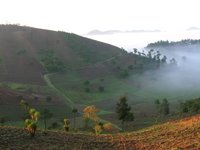 On Thursday, a shuttle dropped Cathy, Jim, and I off on the side of the PanAmerican Highway. Waiting to greet us was Julio Ordonez, a friend of Cathy and Jim's, from the little town of Santa Apolonia about fifteen minutes up into the mountains outside of Tecpan, Guatemala. The town is set on a mountain side and the fields extend throughout the mountain valleys surrounding the town. There is so much to tell about our trip there! But for the moment, here are a few highlights... We woke up at 6.00 am the first morning for a walk through the misty mountain passes around the village. We were greeted by the local farmers on their way to work in their fields and by women on the way to the mill to grind corn for the day.
On Thursday, a shuttle dropped Cathy, Jim, and I off on the side of the PanAmerican Highway. Waiting to greet us was Julio Ordonez, a friend of Cathy and Jim's, from the little town of Santa Apolonia about fifteen minutes up into the mountains outside of Tecpan, Guatemala. The town is set on a mountain side and the fields extend throughout the mountain valleys surrounding the town. There is so much to tell about our trip there! But for the moment, here are a few highlights... We woke up at 6.00 am the first morning for a walk through the misty mountain passes around the village. We were greeted by the local farmers on their way to work in their fields and by women on the way to the mill to grind corn for the day.
The women wear traditional Mayan clothing... a richly embroidered top called a huipile and a long skirt woven by hand on local looms. We were able to spend a few minutes at the local tailor's home, across the street from Julio, to see how the weaving is done. On this loom, a young woman is working on the center part of one of the huipiles. It will take her at least a month to complete this particular piece. In the shop behind her was the huge wooden loom used to create the skirts.
 Julio also took us to visit with Pasquala. We entered her small home through a bright blue metal door walking into a courtyard full of pottery. She took us through the courtyard, past the kitchen, to the back of the house where she makes her pots. The clay comes from the hillside outside of Santa Apolonia. She grinds it into powder, mixes it with water, and then proceeds to shape the pot.
Julio also took us to visit with Pasquala. We entered her small home through a bright blue metal door walking into a courtyard full of pottery. She took us through the courtyard, past the kitchen, to the back of the house where she makes her pots. The clay comes from the hillside outside of Santa Apolonia. She grinds it into powder, mixes it with water, and then proceeds to shape the pot. 
There is no pottery wheel. Instead, she places the clay on the ground and shapes it with her hands, spinning round and round until it takes the shape she desires. Later on it is painted and fired in an earthen kiln. The final product is a rich, red, terra cotta pot colored with black shadings from the kiln.
I have not even touched on the evening prayer meeting, conversations with a modern Mayan family, seeing the resemblences between the Mayan girls and my own nieces, or the afternoon at Iximche, a local Mayan ruin. Those will have to wait for later blogs. For the moment, I leave you with images of traditions that are quickly fading away. Pasquala and her 83 year old aunt are the only ones left in the village who still use the ancient technique for making pots. While many Guatemalans, especially the women, still wear traditional clothing, the family we stayed with, including the grandparents, have all opted for more modern, Western dress.
Julio is hoping to be the next mayor of Santa Apolonia. We spent much time talking of improvements he wants to make to the town. We talked of how to preserve the tradition and bring tourists into the city, how to clean up the streets, and bring education to all. As we talked, I was struck by the tension between tradition and resources. Somehow it seems that in our world in order to bring resources to a community, you have to give in to the wider modern culture. In order to improve the quality of living in one area, you have to lose something in another. There doesn't seem to be any way to preserve the sense of community, the love of culture, the connection with the land, and to provide health care, education, and financial resources. I realize that many are trying to walk this fine line in Guatemala and in the United States. But I wonder why the tension itself exists?
Tomorrow we take a boat around Lake Atitlan and the next day hike Mount Pacaya, an active volcano outside of Antigua. Still to come is Tikal, the great Mayan ruin in the north of the country.
1 comment:
These posts are great. What a fun suprise to click on your site and find you posting. :)
Heidi
Post a Comment